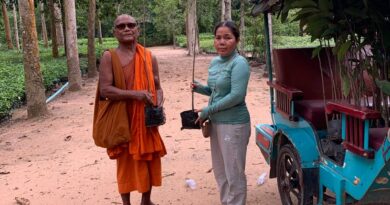អាជ្ញាធរជាតិអប្សរា និងសាកលវិទ្យាល័យហាវ៉ៃបានសហការគ្នាធ្វើកំណាយស្រាវជ្រាវពីការវិវត្ត ស្តីពី «ការគោរពពុទ្ធសាសនាថេរវាទ»ដោយផ្តោតលើ ការវិវត្តរបស់សហគមន៍មនុស្សក្នុងតំបន់នេះ តាំងពីសម័យមុនអង្គរ រហូតមកដល់សម័យកណ្តាល ថាមានការផ្លាស់ប្តូរដូចម្តេចខ្លះ នាពេលដែល «វត្ត» មកជំនួសប្រាសាទ សម័យអង្គរ ដោយបានក្លាយជាស្នូលរបស់សហគមន៍។ តាមរយៈទិន្នន័យ LiDAR បង្ហាញថា មានទួលលំនៅនៅផ្នែកពាយព្យប្រាសាទអង្គរវត្ត នាសតវត្សរ៍ទី១២ ត្រូវឈូសពង្រាបប្រហែលនៅ សម័យកណ្តាល។
លោក ទិន ទីណា អនុប្រធាននាយកដ្ឋានស្រាវជ្រាវ បណ្តុះបណ្តាល និងផ្សព្វផ្សាយនៃអាជ្ញាធរជាតិអប្សរា មានប្រសាសន៍ថា អាជ្ញាធរជាតិអប្សរាបានសហការជាមួយសាកលវិទ្យាល័យហាវ៉ៃ ធ្វើកំណាយស្រាវជ្រាវនេះ គឺក្នុងគោលបំណងដើម្បីស្វែងយល់ពីមូលហេតុនៃការប្រែប្រួលរចនាសម្ព័ន្ធទីក្រុង និងប្រជាសាស្ត្រក្នុងតំបន់អង្គរពីសតវត្សរ៍ទី១៣រៀងមក។ ដូច្នេះ ដើម្បីឆ្លើយតបទៅនឹងគោលបំណតខាងលើនេះបានក្រុមការងារស្រាវជ្រាវបានបើករណ្តៅ កំណាយចំនួន២០រណ្តៅ ទំហំ ១x២ម នៅតាមទួល និងត្រពាំងក្នុងបរិវេណប្រាសាទអង្គរវត្ត។ ក្រៅពីនេះ ដើម្បីទទួលទិន្នន័យបន្ថែមទៀត អ្នកស្រាវជ្រាវ បានខួងដីចំនួន១០៤រណ្តៅបន្ថែមទៀត។ គម្រោងស្រាវជ្រាវនេះ បានចាប់ផ្តើមតាំងពីថ្ងៃទី២១ ខែវិច្ឆិកា ឆ្នាំ២០២២ ហើយនឹងបញ្ចប់នៅថ្ងៃទី២០ ខែមករា ឆ្នាំ២០២៣។
លោក ទិន ទីណា ពន្យល់ថា ទិន្នន័យដែលទទួលបានពីការធ្វើកំណាយនេះអាចឱ្យយើងយល់ពីសហគមន៍ មនុស្សរស់នៅក្នុងរាជធានីអង្គរ ដែលអាចឆ្លើយតបនឹងកត្តាប្រវត្តិសាស្ត្រធំៗមួយចំនួនដូចជា ការផ្លាស់ប្តូរមកកាន់ពុទ្ធសានាថេវាទវិញ ការធ្លាក់ចុះអំណាចកណ្តាល របស់អង្គរ ការធ្លាស់ប្តូររាជធានីទៅភាគខាងត្បូង (ជុំវិញភ្នំពេញ) និងការវិលត្រឡប់នៃអំណាចកណ្តាលមួយរយៈខ្លីនៅសតវត្សរ៍ទី១៦ នៃព្រះមហាក្សត្រសម័យលង្វែក។
លោកមានប្រសាសន៍បន្ថែមថា នៅឆ្នាំ២០១៩-២០២០ ក្រុមស្រាវជ្រាវទាំងពីរស្ថាប័នក៏បានធ្វើកំណាយស្រាវជ្រាវនៅគោកដូនប៉ុក គោកបាក់ និងគោកគង់ នៅតំបន់វត្តអធ្វា នៅគោករកា និងគោកព្រៃអំពិលកើត នៅតំបន់វត្តចេតិយ និងនៅគោកព្រៃអំពិលលិចនៅតំបន់វត្តព្រៃផ្តៅ។ គោលបំណងធ្វើកំណាយស្រាវជ្រាវនេះ គឺដើម្បីប្រមូលទិន្នន័យពីសហគមន៍មនុស្សរស់នៅក្នុងតំបន់ជនបទរាជធានីអង្គរ។
លោក ហេង ពិភាល់ បណ្ឌិតបុរាណវិទ្យានៃសាកលវិទ្យាល័យហាវ៉ៃ និងជាប្រធានគម្រោងស្រាវជ្រាវបានឱ្យដឹងថា ការធ្វើកំណាយស្រាវជ្រាវនេះ ក្នុងគោលបំណងរកមើលពីការផ្លាស់ប្តូររចនាសម្ព័ន្ធទីក្រុង ការផ្លាស់ប្ដូរវិទ្យាសាស្ត្រ មានន័យថា គឺជាការស្វែងរកទីតាំងដែលមនុស្សធ្លាប់រស់នៅទូទៅ។ ការផ្លាស់ប្ដូរវិទ្យាសាស្ត្រនេះ គឺវាទាក់ទងទៅនិងទេសភាព (ស្ថានដីទូទៅ) ថាតើ សណ្ឋានដីដែលមនុស្សធ្លាប់រស់នៅមានការផ្លាស់ប្ដូរយ៉ាងណាខ្លះ?។ ទាក់ទងទៅនឹងប្រវត្តិសាស្ត្រធំៗ មានដូចជា ការផ្លាស់ប្ដូរជំនឿសាសនាពីព្រហ្មញ្ញមកគោរពពុទ្ធសាសនាមហាយាននិងពុទ្ធសាសនាថេរវាទវិញនៅសតវត្សរ៍ទី១៣ តើបានជះឥទ្ធិពលអីខ្លះដល់ភូមិមនុស្សដែលធ្លាប់រស់នៅកណ្ដាលទីក្រុងអង្គរ និងតំបន់ជនបទជុំវិញអង្គរ?។ មួយវិញទៀត ព្រឹត្តិការណ៍ប្រវត្តិសាស្ត្រដែលយើងធ្លាប់ដឹងតៗគ្នា គឺការផ្លាស់ប្តូររាជធានីអង្គរ ថាតើ វាពិតជាការបោះបង់ចោលទីក្រុងអង្គរមែនឬយ៉ាងណា?។
ចាប់តាំងតែពីថ្ងៃទី២១ ខែវិច្ឆិកា ឆ្នាំ២០២២ រហូតមកដល់ត្រឹមថ្ងៃទី១៧ ខែមករា ឆ្នាំ២០២៣ ក្រុមអ្នកស្រាវជ្រាវ នៃអាជ្ញាធរជាតិអប្សរានិងអ្នកជំនាញមកពីសកលវិទ្យាល័យHawai នៃសហរដ្ឋអាមេរិក បានធ្វើកំណាយស្រាវជ្រាវបុរាណវិទ្យាចំនួន២០រណ្តៅ។ នៅតាមរណ្តៅកំណាយទាំងនោះគេបានរកឃើញខឿនវិហារនៃព្រះពុទ្ធសាសនា ថេរវាទធ្វើពីថ្មបាយក្រៀម ដែលមានបង្គោលសីម៉ាធ្វើពីថ្មភក់នៅព័ទ្ធជុំវិញជា៨ទិស ព្រមទាំងរកឃើញបំណែកកុលាលភាជន៍ និងកំទេចធ្យូង ដែលមនុស្សបុរាណបានប្រើប្រាស់ ដែលអាចយកសំណាកទាំងនោះទៅធ្វើការពិសោធន៍ រកចម្លើយទិន្នន័យបាននៅពេលខាងមុខ។
ចាប់តាំងពីអំឡុងឆ្នាំ២០១៣មក ក្រុមការងារស្រាវជ្រាវ ធ្លាប់បានធ្វើកំណាយនៅបរិវេណទួលខាងកើតនៃប្រាសាទអង្គរវត្ត ដោយគេបានរកឃើញសំបកក្រូចថ្លុង គ្រាប់ស្រូវ និងគ្រាប់កប្បាសដែលបន្សល់ទុកពីសម័យបុរាណប្រើប្រាស់៕
អត្ថបទ៖ ឆាយ ផាន់នី
រូបភាព៖ យី សុថា
APSARA National Authority and the University of Hawaii have collaborated to study the evolution of “Theravada Buddhism”, focusing on the evolution of the local community from the pre-Angkor to the post-Angkor period when the “pagoda” replaced the Angkorian temple, becoming the core of the community. According to LiDAR data, settlements in the northwestern area of Angkor Wat in the 12th century were demolished around the post-Angkor period.
Mr. Tin Tina, Deputy Director of the Department of Research, Training, and Communication of APSARA National Authority said that APSARA National Authority has cooperated with the University of Hawaii to excavate to find out the reasons for the changes in urban structure and population in the Angkor area from the 13th century onwards. Therefore, in response to the above objectives, the research team opened 20 excavation pits measuring 1x2m at the mounds and ponds in the Angkor Wat temple complex. In addition, to obtain more data, researchers have dug another 104 pits. This research project started on 21 November 2022 to 20 January 2023.
Mr. Tina explained that the data obtained from this excavation allows us to understand the human community in Angkor, which may respond to several major historical factors, such as the transition to Buddhism, the decline of Angkor civilization, and the move of the capital to the south (around Phnom Penh) and the short time return of the kingdom power in the 16th century.
He added that in 2019-2020, the research team of both institutions also conducted excavations in Daun Pok, Kork Bak, and Kork Kong in the area of Wat Athvea, Kork Roka, and Kork Prey Ampil in the area of Wat Chetdei as well as Kork Prey Ampil Lech in the area of Wat Prey Pdao. The purpose of this excavation was to collect data from communities living in rural areas of Angkor.
Dr. Heng Pipal, Archeologist at the University of Hawaii and head of the research project, said the excavation was aimed at exploring the changing structure of the city. This scientific change was related to the landscape (general landscape), and how the topography that people used to live has changed. In terms of major histories, such as the conversion of Hinduism to Mahayana Buddhism and Theravada Buddhism in the 13th century, what impact did it have on the people who once lived in the Angkor site and the countryside around Angkor? On the other hand, the historical event that we have known for a long time was the change of Angkor, whether it was the abandonment of Angkor or not.
From 21 November 2022 to 17 January 2023, researchers from the APSARA National Authority and experts from the University of Hawaii in the United States excavated 20 archeological pits. In the excavation pits, the laterite foundations of the Theravada Buddhism pagoda were found, with sandstone boundary stones (Bai Sema) encircling them in eight directions, as well as pottery fragments and charcoal fragments used by ancient people. These samples can be used to experiment to get the answers in the future.
Since 2013, researchers have been digging in the eastern mounds of Angkor Wat, finding grapefruit peels, rice, and cotton seeds left over from ancient times.
Article: Chhay Phanny
Photos: Yi Sotha
Share:
Our Latest News

កូនឈើចម្រុះចំនួន៦,៤១៧ដើម ត្រូវបានអាជ្ញាធរជាតិអប្សរាចែកចាយដោយឥតគិតថ្លៃពីថ្ងៃទី១០ ដល់ថ្ងៃទី៣០ ខែមិថុនា ឆ្នាំ២០២៥ -6,417 saplings distributed by the APSARA National Authority - 03 July 2025
– ប្រគេនកូនឈើទាលចំនួន១០០ដើម ជូនព្រះអង្គ កែម លា ព្រះចៅអធិការវត្តថ្កូវ ដើម្បីយកទៅដាំក្នុងបរិវេណវត្ត ស្ថិតនៅឃុំរើល ស្រុកពួក ខេត្តសៀមរាប។




